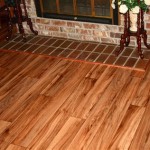Dark Hardwood Flooring: A Deep Dive into Aesthetics, Functionality, and Considerations
Dark hardwood flooring presents a striking visual statement in interior design. Its rich tones evoke feelings of sophistication, luxury, and warmth. Selecting dark hardwood, however, requires careful consideration of various factors to ensure optimal aesthetic impact and long-term performance. This article explores the nuances of dark hardwood flooring, covering its aesthetic benefits, practical considerations, maintenance requirements, and alternative options.
Dark hardwood floors encompass a wide spectrum of shades, ranging from deep browns like walnut and mahogany to nearly black options like ebony and jacobean stains. The specific shade chosen significantly influences the overall ambiance of a room. Deeper, more saturated tones create a dramatic and intimate atmosphere, while lighter shades within the dark spectrum offer a more approachable and versatile feel. The choice should align with the desired aesthetic and the existing architectural features of the space.
The appeal of dark hardwood extends beyond mere aesthetics. Its ability to create a strong visual anchor within a room is a significant draw for many homeowners. Dark floors effectively ground the space, providing a contrast to lighter walls and furnishings. This contrast enhances the perceived depth and dimensions of the room, particularly in spaces with high ceilings or ample natural light.
Furthermore, dark hardwood flooring can serve as a neutral backdrop, allowing other design elements to take center stage. Vibrant rugs, colorful furniture, and bold artwork pop against the dark surface, creating a visually dynamic and engaging environment. The inherent elegance of dark wood lends itself well to a variety of design styles, from traditional and classical to modern and contemporary.
Despite its aesthetic advantages, dark hardwood flooring presents certain practical challenges. Its dark surface readily reveals dust, scratches, and pet hair, requiring more frequent cleaning and maintenance compared to lighter-colored floors. The impact of sunlight on dark wood is also a critical consideration, as prolonged exposure can lead to fading or discoloration over time. Proper UV protection measures, such as window treatments and UV-resistant finishes, are essential to mitigate this risk.
Another potential drawback of dark hardwood is its tendency to absorb light. In smaller rooms or those with limited natural light, dark floors can create a feeling of enclosure and make the space appear smaller. Conversely, in larger rooms with ample natural light, dark floors can contribute to a sense of grandeur and sophistication. Careful consideration of the room's size and lighting conditions is paramount when deciding whether to install dark hardwood flooring.
Durability and Hardness Ratings
The durability of hardwood flooring is a critical factor to consider, especially in high-traffic areas. The Janka hardness scale measures the resistance of wood to indentation and wear. Different wood species exhibit varying hardness ratings, influencing their suitability for specific applications. For example, Brazilian walnut (Ipe) has a very high Janka rating, making it exceptionally durable and resistant to scratches and dents. Conversely, softer woods like cherry are more prone to wear and tear.
When selecting dark hardwood, it is crucial to prioritize species with high Janka ratings, particularly in areas with heavy foot traffic, children, or pets. Opting for engineered hardwood can also enhance durability. Engineered hardwood consists of a core of multiple layers of plywood or other wood composites, topped with a layer of natural hardwood veneer. This construction provides increased stability and resistance to moisture and warping compared to solid hardwood.
In addition to the hardness of the wood itself, the finish applied to the floor plays a significant role in its overall durability. Polyurethane finishes are a popular choice due to their resistance to abrasion, scratches, and water damage. Oil-based polyurethane finishes offer superior durability but require longer drying times and emit stronger odors during application. Water-based polyurethane finishes are a more environmentally friendly option, offering lower VOC emissions and faster drying times, although they may require more coats for optimal protection.
Proper maintenance is essential to preserving the beauty and longevity of dark hardwood flooring. Regular sweeping or vacuuming with a soft brush attachment removes dust and debris that can scratch the surface. Damp mopping with a pH-neutral hardwood floor cleaner is recommended for removing spills and stains. Harsh chemicals and abrasive cleaners should be avoided, as they can damage the finish and dull the wood's natural luster.
Maintenance and Cleaning Protocols
Maintaining dark hardwood flooring requires a consistent and proactive approach. Due to the tendency of dark surfaces to highlight dust and imperfections, a more frequent cleaning schedule than with lighter floors is generally necessary. Implementing preventative measures, such as placing mats at entryways and using furniture pads under heavy items, can significantly reduce wear and tear. Addressing spills promptly is crucial to prevent staining and water damage.
The type of cleaning products used on dark hardwood floors is paramount. Avoid using harsh chemicals, ammonia-based cleaners, or abrasive cleaning pads, as these can strip the finish and damage the wood. Opt for pH-neutral hardwood floor cleaners specifically formulated for dark wood finishes. These cleaners are designed to remove dirt and grime without harming the wood or leaving behind a dull residue.
When mopping dark hardwood floors, use a microfiber mop and wring it out thoroughly to avoid over-wetting the wood. Excess water can seep into the seams between the boards, causing warping and other damage. After mopping, ensure the floor is completely dry. Regular professional cleaning and refinishing may be necessary to restore the floor's luster and remove stubborn stains or scratches. The frequency of professional refinishing depends on the amount of foot traffic and the overall condition of the floor.
Beyond regular cleaning, consider applying a hardwood floor restorer or polish every few months to protect the finish and enhance its shine. These products create a protective barrier that helps to repel dirt and scratches. Always follow the manufacturer's instructions carefully when applying any cleaning or maintenance products to dark hardwood floors.
The impact of environmental factors on dark hardwood flooring should also be considered. Fluctuations in temperature and humidity can cause wood to expand and contract, potentially leading to gaps or cracks. Maintaining a stable indoor climate is crucial to preventing these issues. Using a humidifier during dry winter months and a dehumidifier during humid summer months can help to regulate indoor humidity levels and protect the floor from damage.
Color Variations and Staining Considerations
The inherent color variations in natural wood are further amplified in dark hardwood floors. These variations can add character and depth to the floor, but it's important to understand how they will affect the overall appearance. Some species, like walnut, exhibit a wide range of colors, from light browns to deep chocolates. Others, like ebony, are consistently dark throughout.
When selecting dark hardwood, consider the degree of color variation and whether it aligns with your aesthetic preferences. Samples of the wood should be viewed in different lighting conditions to accurately assess the color and grain patterns. Natural wood variations can be minimized by selecting a specific grade of wood that offers a more uniform appearance. However, embracing these variations can add a unique and organic feel to the space.
Staining is often used to achieve a desired dark color on hardwood flooring. The type of stain and the application technique significantly impact the final result. Oil-based stains typically penetrate the wood more deeply, resulting in a richer and more durable color. Water-based stains offer a more environmentally friendly option with lower VOC emissions, but they may require multiple coats to achieve a comparable depth of color.
Before staining an entire floor, it's crucial to test the stain on a sample area to ensure the desired color and appearance. The wood's natural color and grain patterns will influence how the stain is absorbed, so it's essential to see how the stain looks on the specific type of wood being used. Applying a wood conditioner before staining can help to ensure even stain absorption and prevent blotchiness.
The finish applied after staining also affects the final color. A glossy finish will enhance the depth and richness of the dark color, while a matte finish will create a more subdued and natural look. The choice of finish should align with the overall design aesthetic and the desired level of sheen.
In conclusion, dark hardwood flooring is a powerful design element that can transform a space with its elegance and sophistication. Careful consideration of durability, maintenance, color variations, and environmental factors is essential to ensure a successful installation and long-lasting beauty. By understanding the nuances of dark hardwood, homeowners can make informed decisions that enhance the aesthetic appeal and value of their homes.

10 Beautiful Dark Hardwood Floors To Transform Your Home Next Day

40 Dark Hardwood Floors That Bring Life To All Kinds Of Rooms Farmhouse Flooring Wood Floor Design

Dark Hardwood Floors Your Complete Guide

Thinking Of Staining Your Hardwood Floors A Dark Color

Design A Room With Dark Wood Floors Arimar Hardwood Distributors And Wholers

Thinking Of Staining Your Hardwood Floors A Dark Color

Dark Wood Flooring Free Samples Available Factory Direct

2 Ways To Create A Dark Wood Floor Carlisle Wide Plank Floors

29 Luxurious Dark Hardwood Floors For A Dramatic Statement

Dark Hardwood Floors A Review And The Pros Cons
Related Posts








